Sony D-5 Portable Compact Disc Player
Company Address: One Sony Dr., Park Ridge, N.J. 07656, USA.
When I first encountered this smallest of all CD players, I had to force my way through a crowd of enthusiastic audiophiles who were attending the 1984 Japan Audio Fair. Meanwhile, back in the United States, Sony had elected to introduce this amazing little product at the same time as it was being introduced in Japan. That in it self tells you how important Sony felt this product was going to be.
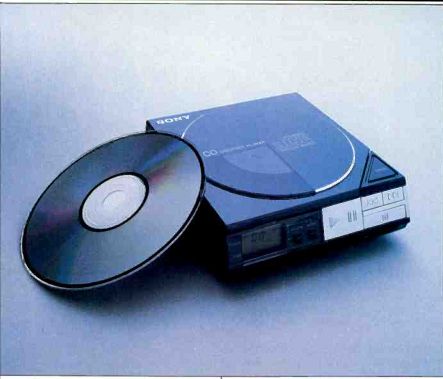
There are several significant break throughs involved in the design of the D-5. First and foremost, it is a very low cost unit, carrying a suggested retail price of less than $300. Second, this CD player can be plugged into a high fidelity system or used on the move with an optional battery pack/carrying case (costing $49.95) and optional stereo headphones of your own choosing.
Finally, the D-5 is actually smaller in width and depth than the plastic case in which CDs are normally packaged; it measures only 5 inches by 5 1/4 inches.
The height of the player is a mere 1 1/2 inches, and it weighs slightly more than 1 1/4 pounds.
Despite its low cost and small size, the D-5 performs very much like its heavier and costlier counterparts, though it lacks the programming and random-access features which have constituted the major differences be tween one CD player and another.
Nonetheless, the most important display and access features have been retained, and, of course, the superb performance inherent in the CD format has not been sacrificed in any way.
The D-5 incorporates a digital liquid-crystal display which lets you know what track is being played, how much time has elapsed on a given track, and, at the press of a button, the amount of time remaining on the entire disc and the number of tracks remaining. In addition, there is a battery condition indicator and two other LCD indications: One for "AMS" (Automatic Mu sic Sensor) and the other for music "Search" or audible fast-scanning of a disc's contents.
After pressing the "Open" button on the D-5's top surface (in the corner), a disc may be loaded directly onto the turntable. A special safety switch automatically disengages the D-5's mechanism whenever the loading door is open. All other controls and the display are found on the player's front. These include a time remaining button for the display, a "Mode" button (which toggles between the "AMS" and "Search' functions), a toggling play/pause but ton, a power switch, a stop button, a continuously variable headphone volume control, and a mini stereo headphone jack. A line-output jack (also a stereo mini type) and a d.c. input terminal are on the rear of the D-5. An a.c. power adaptor which delivers 9 V in the correct polarity is supplied, but the battery contained in the optional case or an optionally available car-battery cord, could also be connected at the d.c. input terminal.
When the battery case is used, it must be loaded with six C-size alkaline batteries whose life is approximately 5 hours at normal listening levels. Re chargeable nickel-cadmium batteries may also be used with the optional battery case. Charging time for these would be around 15 hours, with fully charged nickel-cadmium batteries supplying around 2 1/2 hours of play.
Much of the engineering that made Sony's car CD players possible has also been applied to the D-5. For ex ample, a single-chip, high-density VLSI has been used for primary digital functions and for simplified and stabilized player functions. In addition, the miniaturized laser-optical assembly found in the Sony car CD players has also been used.
Basic performance of the D-5, as might be expected, is very much like that of Sony's car CD units (one of which, the CDX-R7, I measured and reported on for the July 1984 issue).
Sony has, so far, continued to use steep, analog, output filters which cut off above 20 kHz. but response up to that frequency is extremely flat. The usual low distortion and high separation figures can be expected from this player. Output via the line-level jack is approximately 1.6 V, not unlike the voltage levels one expects from a larger table-top or shelf-mounted CD player.
Use of 32-ohm headphones, such as those recommended by the manufacturer, results in a maximum power out put from the phone jack of around 10 mW per channel-enough to drive some of those new high-efficiency stereo headphones.
In my hands-on tests, I found that the D-5's controls operated reliably and positively and that sound quality was as good as that obtained from any of the larger Sony CD players.
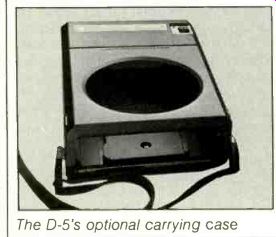
The D-5's optional carrying case
Because of Sony's efforts at creating small, portable music sources such as the famous Walkman, it was inevitable that the D-5 would be greeted in many circles as the "Walkman CD." In fact, Sony emphasizes that this product is not in the Walkman category: It is not intended as a product to be carried on a belt loop by morning joggers. The elaborate stabilizing techniques used in Sony's car CD players have not been incorporated in the D-5 (nor does Sony claim they have been); therefore, if you bounce the unit around too much when a disc is being played, it will mistrack. What Sony did intend for the D-5 was that it be used on a fairly stable surface-at home, walking (not jogging), in the park, on the beach, or wherever else you happen to be when you crave noise-free music reproduction of wide dynamic range. That being the case, Sony seems to have succeeded admirably with its D-5 CD player.
-Leonard Feldman
=============================
Technics SL-XP7 Portable Compact Disc Player
Manufacturer's Specifications:
Frequency Response: 4 Hz to 20 kHz. + 0.5.- 1.0 dB. THD: 0.006%.
Dynamic Range: 90 dB. Number of Programmable Selections: 15. Channel Separation: 90 dB. Line Output Level: 2.0 V. Headphone Output Level: 15 mW into 32 ohms. Power Supply: D.c. ±6 to ±7.2 V, via supplied adaptor. Power Consumption: A.c. adaptor, 8 watts; optional carrying case, 3.2 watts. Dimensions: 4-31/32 in. W x 1 1/4 in. H x 4-31/32 in. D (12.6 cm x 3.19 cm x 12.6 cm). Weight: 1.1 lbs. (0.52 kg). Price: $299.95; optional carrying case with nickel-cadmium battery pack, Model SH-CDB7, $49.95. Company Address: One Panasonic Way, Secaucus, N.J. 07094, USA.
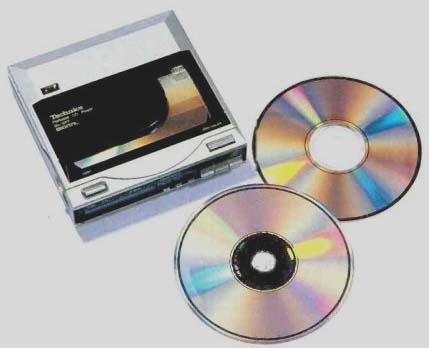
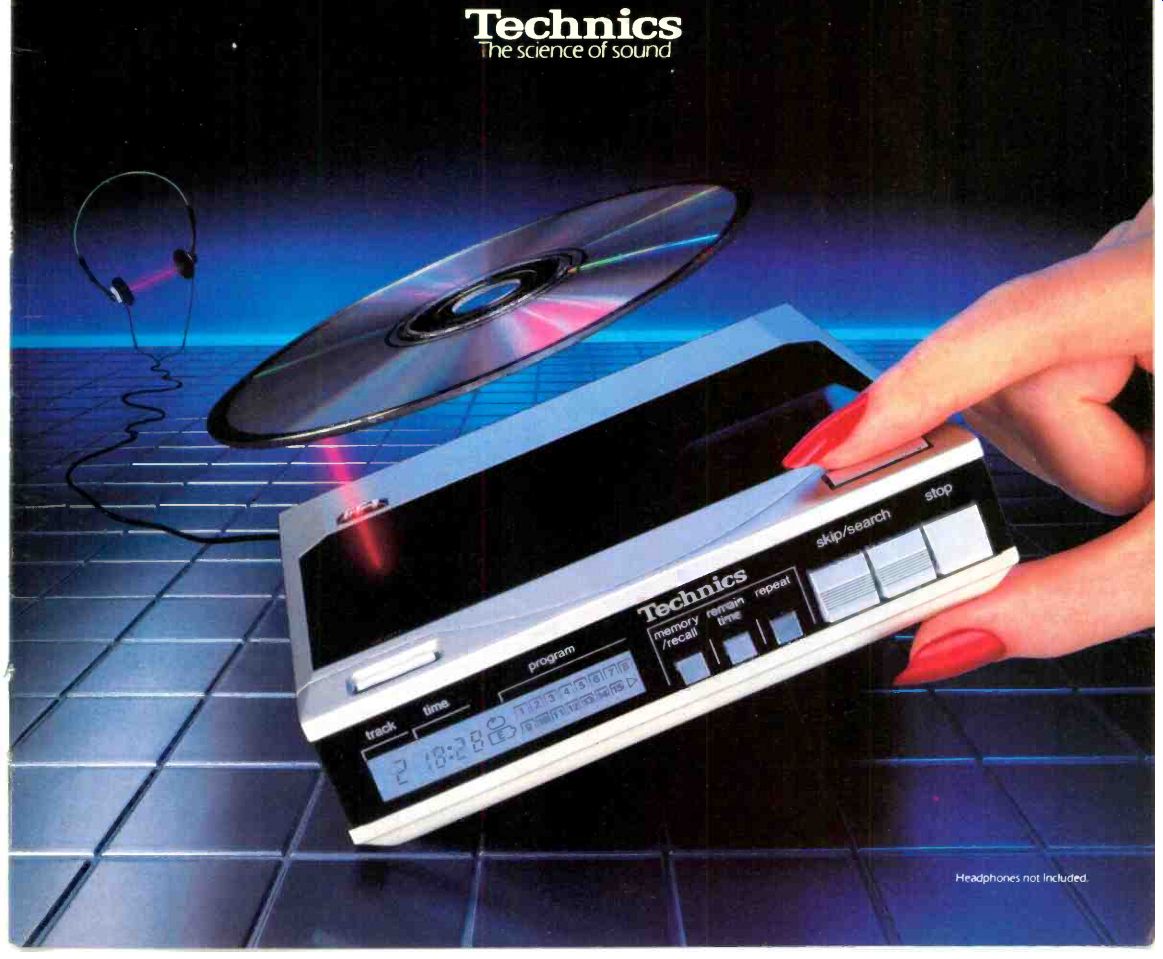
While neither company would readily admit it, it's no secret that Matsushita Electric (the parent company of Technics) and Sony are forever trying to outdo each other when it comes to innovations in consumer-product technology. To Sony goes the credit for coming up with the world's first portable CD player. That unit, the D-5, has been around for about a year now, and it has been very well received. Technics, however, takes Best-of-Class honors for a portable CD player with the most features in the smallest physical package. Consider its size:
Scarcely wider and longer than the diameter of a Compact Disc. That's a tad smaller than the Sony D-5, but the disparity in size is readily apparent when you insert the Technics SL-XP7 into its optional combination carrying case/ battery pack. In this configuration, the Technics portable occupies about 40% less space than the Sony unit similarly installed in its optional battery pack/carrying case.
The single most important feature found on the Technics unit not avail able on the Sony, is random-access programming. Up to 15 selections on a disc can be programmed to be played in any order. In addition, it has the kind of convenience features found on most home CD players, such as forward and backward skipping of tracks, forward and backward audible fast search, and repeat play. There are two miniature output jacks; one is for line-output connection to a home stereo component system, the other for connection to a pair of headphones. The head phone output level is variable. An interesting additional feature is a high-cut filter which affects only the headphone output. Some listeners find that when listening to CDs through headphones, high-frequency content can be a bit too strong. Under these conditions, turning on the high-cut switch provides a gentle roll-off above about 3 kHz.
An LCD display on the unit's front provides fully as much status information as displays found on larger, home CD players. The display will indicate total number of tracks and total playing time (when a CD is first inserted and scanned), track number being played, elapsed or remaining time, the programmed order of tracks, if the "Re peat" 'unction has been activated, and if battery voltage is low.
The SL-XP7 comes with an a.c. adaptor that also serves as the recharger for the nickel-cadmium battery pack 'n the optional case. Frankly, I can't think of any reason why you would buy the CD player and not buy the carrying case/battery pack. It's this option that makes the little CD player portable. Mounted in its carrying case and with a fully charged battery, the player will operate for three full hours.
Recharging takes seven hours if you don't use the SL-XP7 while charging, or 11 hours if you're recharging and listening to CDs at the same time.
However, unlike Sony's D-5, which can be powered using readily available, replaceable C-cells, the SL-XP7 is restricted to the nickel-cadmium batteries built into its carrying case. So, for instance, on a coast-to-coast plane trip you would need two fully charged carrying cases to listen to CDs!
Control Layout
Press the pushbutton on the top-left corner, and the top cover pops open, exposing the turntable onto which the Compact Disc is placed. If the unit's power switch is on, closing the cover sets the turntable spinning. The laser pickup scans the contents of the disc, and the number of tracks and playing time are indicated on the front panel's display. Pressing the play/pause but ton located on the right corner of the top surface begins play from the start of the CD.
Near the display area on the front panel are a "Memory/Recall" button (used for storing programmed tracks and reviewing selected program sequences), a "Remain Time" button (which switches the display during play from track time elapsed to time remaining), and a "Repeat" button.
The repeat function will cause either a single track, all programmed tracks, or the entire disc to be played repeatedly, depending upon what mode of play has been selected. Three larger push buttons, located near the right edge of the front panel, are used for controlling the SL-XP7's forward/skip functions and to stop play or clear a previously memorized program.
The power slide switch is located along the left side panel of the tiny CD player, while the line-out stereo mini-jack and the d.c. input terminal are on the rear panel. The right side panel houses the headphone output jack, its associated thumb-wheel level control, and the on/off slide switch for the high-cut filter.
The optional carrying case is no much larger than the SL-XP7 itself which fits neatly into it, the player's d.c input terminal engaging a mating plug from the carrying case. A cover comes down and, together with a rear thumb screw, firmly locks the CD player in side the rubber-cushioned compartment. For charging the nickel-cadmium battery or for continued a.c. operation, the a.c. adaptor cable, instead of being connected to the d.c. input terminal at the rear of the player, is now plugged into a similar terminal on the rear of the carrying case. A switch on the front of the case can now be set either to "Batt" or "AC/Charge." A shoulder strap is supplied with the carrying case.
Measurements
Let me state at the outset that I was perhaps a bit more critical and careful than usual when conducting bench tests of the Technics SL-XP7. It seemed to me that this little wonder of a CD player could not possibly perform as well as its bigger brothers. But the fact is that it did.
Frequency response was essentially flat from 20 Hz to 20 kHz, with a slight rise near the high end not greater than about 0.3 dB and a roll-off beginning at 20 kHz. As you can see in Fig. 1A, response was down 0.2 dB in the left channel and 0.6 dB in the right channel at 20 kHz. The vertical scale in Fig. 1A is only 2 dB per division, but it is a full 10 dB per division in Fig. 1B, which plots the response of the player with its high-cut filter turned on. Frequencies above 2 or 3 kHz are attenuated at what looks like a rate of 3 to 4 dB per octave, resulting in a-10 dB roll-off at 20 kHz.
As is true of so many CD players, harmonic distortion readings above 10 kHz are deceptive (in fact, rather meaningless). The machines create "beats" between the desired high-frequency signal found on the test disc and the sampling frequency (in this case, 44.1 kHz). This effect is clearly illustrated in the spectrum analysis of Fig. 2, in which the analyzer was linearly swept from 0 Hz to 50 kHz. The tall spike near the center is the desired 20-kHz signal, while the shorter one to its right is an unwanted beat outside the audio frequency range. By introducing a band-pass filter (with a cutoff of 20 kHz), I isolated real harmonic distortion from the non-harmonically related components. Under these conditions, THD at 1 kHz was an unusually low 0.002% at mid-frequencies for recorded output of 0 dB. The three curves in Fig. 3 depict harmonic distortion at 0 dB (maximum) recorded level and at-24 and-30 dB levels. Linearity was nearly perfect from 0 dB output level down to-80 dB output level, with deviation from perfect linearity never exceeding 0.3 dB over that range.
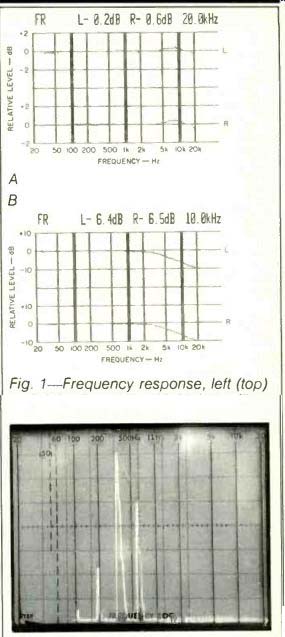
Fig. 1-Frequency response, left (top) and right channels, with high-cut
filter off (A) and on (B). Note change of vertical scale, from 2 dB/div.
(A) to 10 dB/div. (B).
Fig. 2-Spectrum analysis, from 0 Hz to 50 kHz, showing 20-kHz test signal (large spike) and unwanted "beat" outside the audio frequency range.
Fig. 3-Harmonic distortion vs. frequency, at three signal levels.

Fig. 4-S/N analysis, both unweighted (A) and A-weighted (B).

Fig. 5-Separation vs. frequency.
Fig. 6-Reproduction of a 1-kHz square wave.
Fig. 7-Single-pulse test.
Fig. 8-Phase-error check, using tones of 2 and 20 kHz.
Unweighted signal-to-noise ratio measured 88.7 dB, and the A-weighted measurement was 91.7 dB (see Figs. 4A and 4B). SMPTE-IM distortion measured 0.01% at maximum recorded level, increasing to 0.035% at- 20 dB recorded level. CCIF-IM distortion (twin-tone, using 19- and 20-kHz tones at the equivalent of highest recorded level) was a low 0.0367% at maximum recorded level and 0.0088% at -10 dB recorded level.
Stereo separation, plotted as a function of frequency in Fig. 5, ranged from 60.2 dB at the high-frequency extreme to 88.4 dB at mid- and low frequencies. The SL-XP7's separation was one of the few parameters that did not measure up to larger CD players. This may well be because of the necessarily close proximity between analog or post-D/A components of the left- and right-channel circuitry; I doubt if it has anything to do with the player's digital circuitry. In any event, even 60 dB of separation between channels is about 35 to 40 dB better than what you can expect from most phonograph cartridges at mid-frequencies, and about 45 to 50 dB greater than the separation provided by phono pickups at high frequencies.
Reproduction of a 1-kHz square wave is shown in Fig. 6. The reproduced wave shape is typical of that produced by CD players which employ steep, multi-pole analog filters. Reproduction of the unit pulse in Fig. 7 further confirms the use of a multi-pole or "brick-wall" filter in this unit's post-D/A output circuitry.
As is true of most CD players that employ analog filters, the SL-XP7 exhibited substantial phase shift or phase error when reproducing high-frequency signals. An attempt to illustrate this effect is shown in Fig. 8; the time relationship between 2- and 20-kHz signals is depicted in this dual-trace oscilloscope photo. Had the two signals been in correct time relationship, both would have crossed the zero axis in a positive-going direction at the same instant. As Fig. 8 illustrates, that is not the case here, indicating at least a 180° phase shift of the 20-kHz signal component, if not more.
Since this CD player was designed for portable as well as in-home use, I felt certain its makers would give special emphasis to good tracking as well as good error-correction capability. I was right. Not only was the player able to play through the test disc's simulated scratch, the 800-micron-diameter simulated dust particles, and the simulated fingerprint smudge, but its resistance to vibration and shocks applied to its top surface was incredible, to say the least. I'll have more on this in a bit.
Use and Listening Tests
Like the portable Sony player I tested some months ago, the Technics SL XP7 is not intended for use by joggers-at least not while they're jogging. I did, however, subject the unit to a very practical test that should give you an idea of just how incredibly stable its tracking system is. Using a pre production version of an adaptor that enables a portable CD player to be heard through a car-stereo system, I road-tested the SL-XP7 over "speed bumps" in a large parking lot and on local streets. Essentially I duplicated a test that Ivan Berger, Technical Editor of Audio, and I devised some months back when we tested the first car CD player.
The adaptor I used for my test was designed for Recoton by Larry Schotz, the Wisconsin inventor who has de signed circuits and products for such firms as NAD, Proton, Nakamichi and Crown International. Unlike another adaptor, released by Sparkomatic, which plugs into the outputs of a portable CD player and the antenna input of a car radio, Schotz's device requires no physical wiring or connection to the car stereo. (The Sparkomatic adaptor modulates the CD signals onto a FM frequency, to which you then tune your car FM radio. It's a neat idea, but of course it's limited by the performance, frequency response and dynamic range of FM radio-and of your particular car radio.) Schotz's adaptor delivers the full, flat frequency response of the CD you're playing and, if your car-stereo amplifier can handle it, the full dynamic range of the CD as well.
In any event, since I was fortunate enough to have a handmade prototype of this novel CD adaptor, I plopped it and the Technics SL-XP7 alongside me in the front seat of my car and went for a bumpy drive. Even barreling over the parking lot's speed bumps at something more than the five miles per hour for which they were intended, the Technics CD player-simply resting on my car seat-did not mistrack or skip even once. The same performance held true for more ordinary driving, though my town's streets are anything but smooth.
I suspect that players such as the Technics SL-XP7 will prove to be the ideal solution for those people who want CD's quality sound in their cars but aren't ready to mount a player in or under the dash, for fear of theft or simply because of the high cost of car units. The nice thing about using the SL-XP7 in this manner is that, when I was through with my drive, I simply picked up the player in one hand and the tiny Recoton adaptor in the other and took them inside my house, where they were safely secured for the night.
The various convenience features of the Technics player worked perfectly, at rest and on the move, including the programming feature and all of the handy display functions. Sound quality, which should still be the primary concern for anyone investing in a CD player, was excellent. As much as I am a purist at heart, there were some CDs (to which I listened at home through a good pair of headphones) which benefited greatly when I turned on the high-cut filter. (As with all such signal-modifying features, it's always nice, too, to be able to turn it off when you don't think it's required.) Of course, one shouldn't look upon a new model solely from the standpoint of its superiority over what's come before, but as of this moment, the Technics SL-XP7 is a clear winner in the portable CD player category. What, if anything, does it lack? Well, a wireless remote control.
However, this entire CD player is not much larger than some of the more elaborate infrared remote-control modules I've seen lately, so why bother!
-Leonard Feldman
(Audio magazine, Apr. 1986)
Also see:
A Compact Introduction to the Compact Disc (Apr. 1986. CD)
Living With CDs (Apr. 1986, CD)
Yamaha CD-3 Compact Disc Player (Apr. 1986. CD)
= = = =